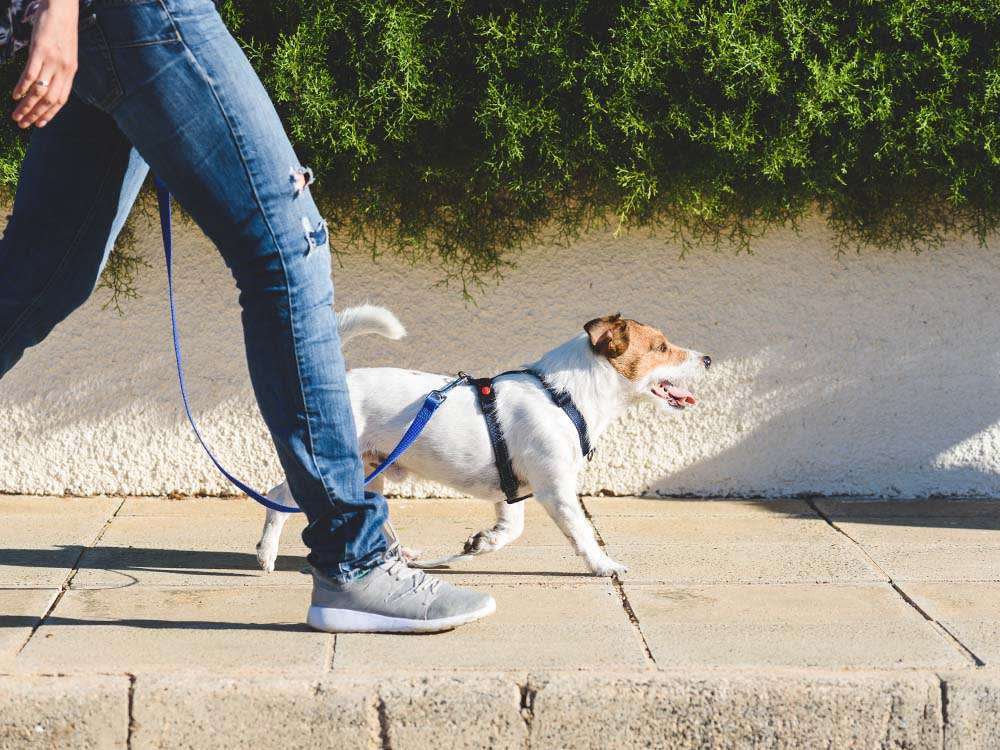Welcome to our guide on dog walking frequency! Are you unsure about how often you should be taking your furry friend out for a stroll? Look no further, as we provide expert advice and tips on finding the perfect balance for your dog's exercise needs.
Key Takeaways:
- Walking your dog daily is essential for their physical and mental well-being.
- The frequency and duration of walks depend on your dog's breed, age, size, and health condition.
- Aim for at least 30 minutes to an hour of exercise every day to keep your dog healthy and prevent obesity.
- Regular walks help in preventing behavioral issues such as excessive barking, chewing, or digging.
- Consider breaking up walks into multiple shorter sessions if you have a busy schedule or a high-energy dog.
Why Walking Your Dog Regularly is Important
Dogs are active animals that need regular exercise to stay healthy and happy. Walking your dog regularly is important because it provides them with the physical activity they need to maintain a healthy weight and strong muscles. It also helps to keep their joints flexible and reduces the risk of obesity, which can lead to various health problems.
Additionally, walking your dog allows them to explore their surroundings, which is important for their mental stimulation. Dogs have a natural instinct to sniff and investigate their environment, so going for walks gives them the opportunity to satisfy this instinct. It can also help prevent behavioral problems such as excessive barking or chewing, as dogs who are bored or understimulated may engage in these behaviors.
Walking your dog regularly also strengthens the bond between you and your furry friend. Spending quality time together during walks allows you to build trust and create a deeper connection. It's not only beneficial for your dog's well-being but also for yours, as walking can be a great way for you to relax and relieve stress.
How Often Should You Walk Your Dog?
The frequency of dog walks depends on several factors such as your dog's age, breed, size, and overall health. Generally, most dogs benefit from at least one walk per day. However, some high-energy breeds may require more frequent walks or additional exercise sessions throughout the day.
If you have a puppy or a young dog, they may have more energy and require multiple shorter walks throughout the day. Puppies have developing muscles and bones that need exercise but should avoid strenuous activities until they are fully grown.
On the other hand, older dogs may not have as much energy as younger ones but still need regular exercise to keep their joints mobile and maintain muscle tone. Older dogs may benefit from shorter walks or gentler exercises, depending on their individual needs.
It's important to note that every dog is unique, so it's essential to observe your dog's behavior and adjust their walking routine accordingly. If you're unsure about how often you should walk your dog, consulting with a veterinarian can provide valuable guidance tailored to your dog's specific needs.
The Benefits of Daily Dog Walking
Daily dog walking has numerous benefits for both dogs and their owners. Firstly, it helps to keep dogs physically fit and maintain a healthy weight. Regular exercise through walking helps to burn off excess energy and calories, preventing obesity and related health issues such as diabetes or joint problems.
Additionally, daily walks provide mental stimulation for dogs. Exploring new environments, encountering different smells, and interacting with other dogs or people can help prevent boredom and reduce destructive behaviors like chewing or excessive barking.
Improved Bonding
Furthermore, daily walks strengthen the bond between dogs and their owners. Spending quality time together during walks allows for increased communication, trust-building, and understanding between the two. This can lead to a stronger relationship based on mutual respect and companionship.
How Exercise Helps Keep Dogs Healthy
Regular exercise is essential for maintaining a dog's overall health and well-being. Physical activity helps to improve cardiovascular health by strengthening the heart and promoting proper blood circulation throughout the body.
In addition to cardiovascular benefits, exercise also aids in maintaining healthy joints and muscles. Regular movement through activities like walking or running helps to keep muscles toned and flexible while reducing the risk of stiffness or arthritis in older dogs.
Mental Stimulation
Besides physical advantages, exercise provides mental stimulation that is crucial for a dog's cognitive development. Engaging in physical activities challenges their problem-solving skills, enhances their learning abilities, and promotes better focus and concentration.
Factors that Determine How Often to Walk Your Dog
The frequency of dog walking depends on various factors that should be considered when determining an appropriate schedule. Firstly, breed plays a significant role as some breeds require more exercise than others due to their energy levels and natural instincts.
Age is another crucial factor. Puppies have higher energy levels and shorter attention spans, necessitating more frequent walks compared to older dogs. Additionally, a dog's overall health, size, and weight should be taken into account when determining the frequency of walks.
Time Availability
Furthermore, the owner's schedule and availability also influence how often a dog can be walked. Owners with busy lifestyles may need to consider hiring a dog walker or utilizing doggy daycare services to ensure their pet receives adequate exercise.
The Consequences of Not Walking Your Dog Enough
Failing to provide sufficient exercise through regular walks can have negative consequences for both the physical and mental well-being of dogs. One significant consequence is weight gain and obesity, which can lead to various health issues such as diabetes, heart disease, or joint problems.
Inadequate exercise can also result in behavioral problems. Dogs that do not receive enough physical activity may become restless, anxious, or exhibit destructive behaviors like chewing furniture or excessive barking.
Poor Socialization
Moreover, insufficient walking deprives dogs of socialization opportunities. Regular walks allow them to interact with other dogs and people, helping them develop proper social skills and reducing the likelihood of aggression or fear towards unfamiliar situations.
Signs that Indicate if a Dog Needs More or Less Walking
Dogs communicate their needs through various signs that indicate whether they require more or less walking. If a dog appears restless or exhibits excessive energy indoors, it may be an indication that they need more physical activity.
Conversely, if a dog seems lethargic or disinterested in going for walks, it might suggest they are getting too much exercise or experiencing fatigue. Paying attention to changes in behavior, energy levels, or overall enthusiasm during walks can help determine the appropriate amount of exercise needed.
Physical Signs
Physical signs such as weight gain or loss, muscle stiffness, or difficulty in movement can also indicate whether a dog needs more or less walking. Consulting with a veterinarian is recommended if any concerning physical signs are observed.
The Ideal Duration for Each Dog Walk and Its Importance
The ideal duration for each dog walk depends on various factors such as breed, age, and overall health. As a general guideline, most dogs benefit from at least 30 minutes to an hour of daily exercise through walking.
The importance of the duration lies in providing enough time for dogs to engage in physical activities that promote cardiovascular health, muscle toning, and mental stimulation. Longer walks allow for more exploration and interaction with the environment, contributing to a happier and healthier dog.
Varying Intensity
It's important to note that the intensity of the walk should also be considered. Some dogs may require shorter but more intense walks to meet their exercise needs effectively. Consulting with a veterinarian or professional dog trainer can help determine the ideal duration and intensity for specific breeds or individual dogs.
Special Considerations for Certain Breeds or Older Dogs When Determining How Often to Walk Them
Certain breeds have specific exercise requirements that should be taken into consideration when determining how often they need to be walked. High-energy breeds like Border Collies or Huskies typically require more frequent and vigorous exercise compared to low-energy breeds like Bulldogs or Basset Hounds.
Older dogs may have reduced stamina and joint issues that require adjustments in their walking routine. While they still benefit from regular exercise, it may be necessary to shorten the duration or provide more frequent but shorter walks to avoid overexertion.
Consulting Professionals
Consulting with breed-specific organizations, veterinarians, or professional dog trainers can provide valuable insights into the exercise needs of specific breeds or older dogs. They can offer guidance on how often and how intensely these dogs should be walked to ensure their health and well-being.
| In conclusion: |
| Regular walks are essential for the well-being of your dog. |
| Daily walks are recommended for most dogs, at least 30 minutes to an hour. |
| However, the specific needs may vary depending on your dog's breed, age, and health. |
| Consult with your veterinarian to determine the ideal walking routine for your furry friend. |
Is it OK to not walk my dog everyday?
However, there is some positive news! While taking your dog for a walk is beneficial for their physical health and mental stimulation, occasionally missing a day won't make you a bad dog owner.
How long can a dog go without a walk?
It is not recommended to leave any dog, regardless of age, alone for more than 8 hours. Different breeds have varying social needs, with hounds being very social and some working breeds or guard dogs being okay alone for 10-12 hours.
How often should you walk your dog if you have a backyard?
According to Fiendish, it is recommended to walk your dog for at least 15 to 20 minutes every day, and even more if your dog doesn't have access to a backyard. It is advisable to consult with your veterinarian to determine the suitable duration for walks if your dog has any health issues.
Is it cruel to only walk dog once a day?
Every dog requires a daily walk outdoors, however, for more energetic breeds, it is necessary to walk them more frequently and for longer durations. Younger dogs are generally more active than older ones, so the age of the dog also influences the frequency of walks.
Is 1 walk a day enough for a dog?
Unless your veterinarian specifies otherwise, it is typically recommended to walk most dogs at least once or twice per day.
How do you tire a dog out without walking?
Engage your dog by squeaking their preferred toy, rolling a ball on the floor, or scattering treats around the room. Your dog will be challenged to resist the temptation and stay in one place, which will mentally stimulate them and lead to quick exhaustion. Best of luck!

















